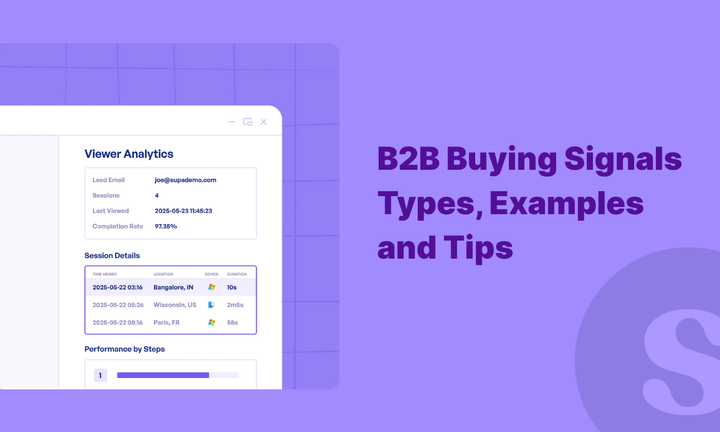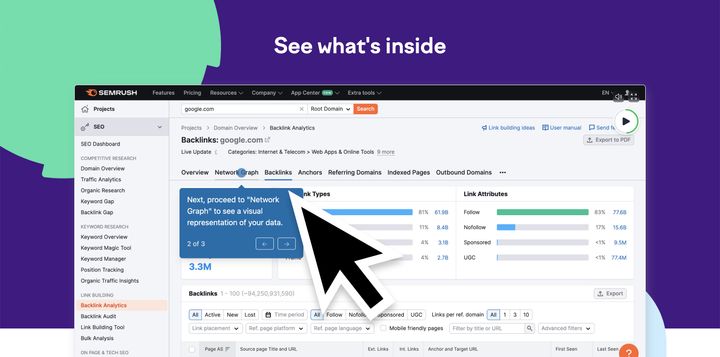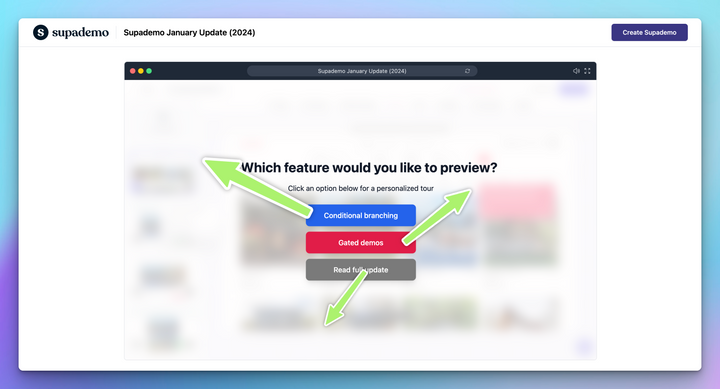Most B2B buyers research silently, leaving scattered clues about their intent — from revisiting your pricing page to testing an interactive demo. Recognizing and acting on these buying signals can help sales teams focus on the right accounts, boost conversions, and shorten deal cycles.
This guide breaks down 15 key buying signals, ranked from strongest to weakest, and shares practical tips on how to respond — so you can engage prospects at the perfect time and turn intent into revenue.
Most B2B sales teams struggle to know when a prospect is actually ready to buy. Buyers research quietly, compare multiple solutions, and often leave only faint traces of intent. The result? Reps waste time chasing the wrong accounts while real opportunities slip through the cracks.
The signs are there, but they’re scattered across multiple channels — from revisiting your pricing page, to engaging with a niche webinar, to asking about integrations. Miss these signals, and you risk being invisible until it’s too late.
The key is knowing which actions actually indicate readiness to buy, and responding in a way that matches the signal’s strength. In this guide, you’ll learn the different types of B2B buying signals, see 15 examples ranked from strong to weak, and get practical tips on how to act on each one effectively.
What are buying signals?
B2B buying signals are the actions, behaviors, or events that indicate a prospect may be considering a purchase. They act like breadcrumbs buyers leave behind, some obvious and others subtle, as they move through the decision-making process.
Buying signals can broadly take 3 forms:
- Verbal signals: when a prospect says they’re interested, asks about pricing, or raises specific objections during a conversation.
- Non-verbal signals: attentive body language in a meeting, taking notes during a demo, or reviewing your materials in detail.
- Digital signals: repeat visits to high-intent pages, signing up for a webinar, or engaging with an interactive demo.
The strength of each signal varies, but the goal is the same: to help sales and marketing teams identify which accounts are in-market now and to guide outreach with timing and context that resonates.
Why buying signals matter in B2B sales?
In B2B sales, timing is everything. Reaching out too early can make you look pushy, while waiting too long means a competitor may already have their foot in the door. Buying signals bridge that gap by showing you when a prospect is most receptive.
Buying signals matter for several reasons:
- More qualified pipeline: By focusing on accounts that display clear intent, sales teams generate a healthier pipeline filled with opportunities that are more likely to convert.
- Higher conversion rates: Recognizing strong signals and acting on them quickly moves prospects through the funnel faster, turning interest into deals at a higher rate.
- Shorter sales cycles: When outreach is based on buyer readiness, conversations become more efficient, which reduces time from first touch to closed deal.
- Better resource allocation: Marketing and sales can prioritize the accounts most likely to buy, ensuring budget and effort go where they deliver the highest return.
- Stronger customer experience: Responding to signals with relevant content or tailored conversations builds trust and positions your company as a partner rather than a pushy vendor.
15 Buying signals in B2B you should look for
Not all signals carry the same weight. Some tell you a prospect is ready to buy today, while others simply mean you’re on their radar.
Here’s a breakdown of 15 buying signals and how to use them in your sales motion.
1. Interactive demo engagement
When a prospect spends time inside an interactive demo, it signals more than curiosity. Unlike reading a blog or skimming a landing page, they’re actively testing your product against their needs and imagining how it fits into their workflow. That level of engagement is a clear sign of intent.
Interactive demos are most effective when placed in areas where buying decisions are made. On bottom-of-funnel pages like pricing, features, or security, demos give high-intent visitors a self-serve way to evaluate your solution. They also perform well in mid-funnel assets such as “how-to” guides, where prospects are exploring specific use cases.
This approach isn’t just theory. Newsletter platform beehiiv embedded interactive demos created using Supademo across its site and saw a dramatic lift in conversions.

In just two months, interactive demos drove thousands of signups, added over $10k in self-serve revenue, and improved free-to-paid conversions by 50% over the site average.
How to act:
- Segment prospects based on which demo flows they engaged with, so sales can tailor follow-up to their priorities. If they focus on integrations, start your follow-up by highlighting how your product seamlessly connects with their existing stack.
- Run A/B tests on demo design, length, and placement to continuously improve conversion rates.
- Use demo analytics to spot drop-off points and refine the flow so prospects reach the “aha” moment faster.
Want to see how interactive demos can help you qualify more leads? Try Supademo now for free!
2. Demo or trial requests
A trial or demo request is one of the clearest buying signals. It shows the prospect has done their research and is seriously evaluating solutions. At this stage, they’re not just curious, they’re exploring whether your product can solve their problem.
How to act:
- Respond quickly to keep the momentum alive.
- Personalize the demo or free trial experience to match the prospect’s role, challenges, and goals.
- Use the conversation to uncover pain points and position your product as the best fit.
3. Direct pricing inquiries
When a prospect asks about pricing, it’s a strong signal they’re actively evaluating vendors. They’re comparing cost against perceived value and trying to determine if your solution fits their budget and priorities. This usually means you’ve made it onto their shortlist.
How to act:
- Don’t just send a price sheet. Frame the conversation around value.
- Share relevant case studies or ROI examples that show how similar companies got results.
- Be transparent about what’s included in each package so there are no surprises later.
4. RFP submissions
A Request for Proposal (RFP) is a clear sign that a company is moving forward with a purchase. They’ve identified a problem, secured internal buy-in, and are now actively comparing vendors. While you may not be the only one in the running, being invited to respond means you’re on their radar as a serious contender.
How to act:
- Position your response around outcomes, not just technical specs. Show how your solution impacts revenue, efficiency, or risk reduction.
- Make your response easy to navigate, with clear value statements tied to the prospect’s goals.
- Where possible, supplement the RFP with a tailored call or presentation to build a stronger connection beyond the document.
5. Engaged interaction with sales reps
Active engagement is one of the clearest indicators of buying intent.
As Marc Wayshak, sales strategist, puts it,
“When prospects ask thoughtful, insightful questions during your presentation, that’s a powerful buying signal. It means they’re actively thinking about how your solution fits into their world.”
When prospects engage deeply, they reveal priorities, roadblocks, and decision dynamics that can help you tailor your follow-up.
How to act:
- Keep the momentum going by confirming next steps at the end of every interaction.
- Note specific pain points, phrases, or questions in your CRM so you can personalize every next touchpoint.
- Include an interactive demo link so champions can share it internally. With tools like Supademo, you can bundle multiple demos into one link to showcase key features and use cases in a single, easy-to-share experience.
Here's an example of a multi-demo showcase collection:
6. Questions about integrations or customizations
When a prospect asks how your product integrates with their tools or whether it can be customized, it shows they’re seriously considering how it would fit into their existing workflows. At this point, they’re no longer just learning about your solution — they’re testing whether it’s viable in their environment.
How to act:
- Be ready with clear answers and resources such as integration guides, customer examples, or short demo videos.
- If they mention a specific system, offer to walk them through exactly how the connection works.
- Highlight flexibility — but avoid overpromising if a customization isn’t supported.
7. Repeated visits to high-intent pages
Not every website visit means a buyer is ready to engage. But when a prospect keeps returning to high-intent pages like pricing, security/compliance, feature breakdowns, or case studies, it’s a strong indication they’re evaluating your solution seriously. These pages often appear late in the research phase, when teams are preparing to make a decision.
How to act:
- Set up alerts or lead scoring to flag repeat visits to these pages.
- Follow up with content or outreach that speaks directly to the topics they explored (e.g., security certifications, ROI comparisons).
- Consider running retargeting campaigns focused on these pages to reinforce your value proposition.
8. Leadership changes
When new executives or department heads step in, they often look for quick wins and may revisit existing tools or processes. A change at the VP or C-level can reset priorities, open new budgets, and create opportunities for vendors offering solutions that align with their vision.
Sales expert Jake Dunlap puts it best:
“When a prospect brings new people into the conversation, don’t panic. It’s one of the strongest buying signals you’ll ever see.”
How to act:
- Reach out quickly with a personalized note congratulating them on the new role.
- Position your product as a way to help them deliver impact in their first few months.
- If you already work with the company, use the leadership change as a chance to reinforce your value and expand adoption.
9. Funding rounds
A fresh round of funding is often followed by new hiring, scaling initiatives, and larger budgets. Companies at this stage are under pressure to grow rapidly, which typically involves investing in tools and services that support expansion. For sales teams, this is a strong signal that the account may be open to new solutions.
How to act:
- Monitor funding announcements in your target industries and set up alerts.
- Tailor your outreach to the growth initiatives they’re likely to prioritize, such as hiring, revenue expansion, or product development.
- Show how your solution can help them move faster or stretch their new capital further.
10. Mergers & acquisitions
Mergers and acquisitions often bring major organizational changes — new leadership, overlapping systems, and the need to streamline operations. These transitions usually trigger technology reviews, consolidations, and fresh budgets to support integration efforts. For vendors, this creates a window to position solutions that simplify or accelerate the post-M&A transition.
How to act:
- Keep an eye on M&A announcements within your target accounts.
- Reach out with messaging that focuses on efficiency, consolidation, and cost savings.
- If you already work with one of the merging companies, use this as a chance to expand your footprint across the combined organization.
11. Participation in product-specific webinars or events
Attending a product-focused webinar or event goes beyond general education — it’s a sign that a prospect is actively exploring how your solution works. Unlike broader industry events, these sessions usually attract people who are closer to making a buying decision and want hands-on insights.
How to act:
- Follow up promptly with attendees, ideally within 24 hours, while the content is still fresh.
- Personalize your outreach by referencing specific topics covered in the session.
- Offer a one-on-one demo or additional resources to help them dive deeper.
12. Positive response to cold outreach
Most cold outreach goes unanswered. Even a small signal, such as a reply to your email, willingness to take a call, or openness to share information, is meaningful. It shows you have caught their attention and created an opening, even if they are not ready to buy immediately.
How to act:
- Treat the first reply as a starting point, not a closed deal.
- Use the opportunity to ask thoughtful discovery questions about their priorities and timeline.
- If the timing isn’t right, continue nurturing with relevant content and light, value-driven touchpoints.
13. Content downloads
When someone downloads a whitepaper, case study, or eBook, it shows awareness of your brand and interest in learning more. On its own, though, it is usually a low-intent signal. Many people download content for research or curiosity rather than being ready to buy.
How to act:
- Treat downloads as the start of a nurture path, not a sales trigger.
- Use follow-up emails to share related resources and guide the prospect toward more high-intent actions like a webinar or demo.
- Track which topics resonate most, since this can reveal the prospect’s focus area like security, ROI, or integrations.
14. Newsletter sign-ups
A newsletter subscription indicates that a prospect wants to stay connected with your brand. While this is a sign of interest, it’s generally a weak buying signal since many people subscribe for insights or industry news rather than an immediate solution.
How to act:
- Use newsletters to build trust over time by delivering valuable, non-promotional content.
- Segment subscribers and gradually introduce product-focused stories once engagement is established.
- Watch for subscribers who consistently engage with CTAs or product-related content — these are stronger leads worth prioritizing.
15. Community or forum participation
When prospects ask questions or join conversations in communities like LinkedIn groups, Slack channels, or industry forums, they’re signaling active interest in solving a problem. Unlike passive signals, community engagement often reveals specific pain points, comparisons, or buying intent in real time.
How to act:
- Identify the top 2–3 communities where your ICP is most active, such as niche Slack groups or LinkedIn sub-communities, and assign ownership within your team to monitor them weekly.
- When a prospect raises a problem, reply with a practical tip or resource and follow up privately with a deeper guide, case study, or short demo link.
- Tag and log these interactions in your CRM so sales can reference the exact conversation when reaching out, making the outreach feel timely and relevant.
Real-world example of using intent signals
Leon Capaldo, Head of Commercials at Snitcher, says:
We didn’t start with the data. We looked at what actually defined our best deals, what hiring patterns or challenges triggered a purchase, and built campaigns around those signals. Once we tied them to our outreach and content, reply rates shot up and acquisition costs dropped dramatically
Snitcher layered multiple buying signals, such as hiring activity, ad launches, and competitor engagement, to identify in-market accounts. This data-driven focus helped them prioritize high-intent prospects and drive growth faster without increasing spend.
Results after 90 days:
- Reply rates increased from <1% to over 10%
- 25% higher trial-to-paid conversions
- 500% improvement in campaign efficiency
- Scaled to $1.6M ARR while maintaining lean marketing spend
Key takeaway: Snitcher’s story proves that buying signals are not just data points. When used strategically, they can turn scattered insights into a predictable, high-efficiency growth engine.
Make the most of your buying signals
If you’ve made it this far, now is the right time to act on buying signals strategically. The signals are clear, whether it’s a demo request, a pricing question, or repeat visits to high-intent pages. What matters is how quickly and effectively you respond.
Interactive demos are one of the most effective ways to capture and strengthen buying intent. With Supademo, you can embed interactive demos not only on your website but also across G2, trade shows, social media, and outbound campaigns. Use them to generate interest, secure stakeholder buy-in, and show value faster in sales conversations.
Try Supademo today to create high-converting demos that turn intent into revenue.
FAQs
What are examples of B2B buying signals?
Examples of B2B buying signals include demo requests, pricing inquiries, repeat visits to high-intent pages, job postings, funding rounds, and engagement with product-focused webinars. Each reflects buyer readiness at different levels, helping sales teams prioritize accounts that are most likely to convert.
How do you identify buying signals in sales?
You identify buying signals by tracking prospect actions across conversations, digital channels, and intent tools. Look for patterns such as repeated page visits, direct questions, or engagement with your sales team. The key is separating curiosity from signals that show real buying intent.
What’s the difference between weak and strong buying signals?
Strong buying signals, like demo requests or pricing questions, suggest immediate purchase intent. Weak signals, such as newsletter sign-ups or content downloads, indicate early interest but not readiness to buy. Sales teams should prioritize strong signals while nurturing weaker ones until intent strengthens.
How can intent data improve B2B sales?
Intent data highlights which accounts are actively researching solutions like yours. This allows sales and marketing to focus outreach on in-market buyers, personalize messaging based on context, and engage at the right time. The result is shorter cycles and higher conversion rates.




